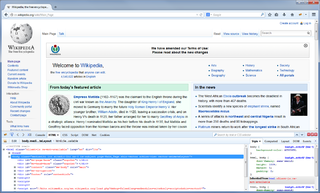A browser engine is a core software component of every major web browser. The primary job of a browser engine is to transform HTML documents and other resources of a web page into an interactive visual representation on a user's device.
WebKit is a browser engine developed by Apple and primarily used in its Safari web browser, as well as all web browsers on iOS and iPadOS. WebKit is also used by the PlayStation consoles starting with the PS3, the Tizen mobile operating systems, the Amazon Kindle e-book reader, Nintendo consoles starting with the 3DS Internet Browser, and the discontinued BlackBerry Browser.
Mozilla Firefox has features which distinguish it from other web browsers, such as Google Chrome, Safari, and Microsoft Edge.
Netscape Plugin Application Programming Interface (NPAPI) is a deprecated application programming interface (API) for web browser plugins, initially developed for Netscape Navigator 2.0 in 1995 and subsequently adopted by other browsers.
In computing, quirks mode is an approach used by web browsers to maintain backward compatibility with web pages designed for old web browsers, instead of strictly complying with web standards in standards mode. This behavior has since been codified, so what was previously standards mode is now referred to as simply no quirks mode.

Progressive enhancement is a strategy in web design that puts emphasis on web content first, allowing everyone to access the basic content and functionality of a web page, while users with additional browser features or faster Internet access receive the enhanced version instead. This strategy speeds up loading and facilitates crawling by web search engines, as text on a page is loaded immediately through the HTML source code rather than having to wait for JavaScript to initiate and load the content subsequently, meaning content ready for consumption "out of the box" is served immediately, and not behind additional layers.
A CSS hack is a coding technique used to hide or show CSS markup depending on the browser, version number, or capabilities. Browsers have different interpretations of CSS behavior and different levels of support for the W3C standards. CSS hacks are sometimes used to achieve consistent layout appearance in multiple browsers that do not have compatible rendering. Most of these hacks do not work in modern versions of the browsers, and other techniques, such as feature support detection, have become more prevalent.
Scalable Inman Flash Replacement (sIFR) is an obsolete JavaScript and Adobe Flash dynamic web fonts implementation, enabling the replacement of text elements on HTML web pages with Flash equivalents. It is open-source and was initially developed by Mike Davidson and improved by Mark Wubben. It is a scalable variety of HTML text-to-flash replacement pioneered by Shaun Inman.

Firebug is a discontinued free and open-source web browser extension for Mozilla Firefox that facilitated the live debugging, editing, and monitoring of any website's CSS, HTML, DOM, XHR, and JavaScript.

Web typography, like typography generally, is the design of pages – their layout and typeface choices. Unlike traditional print-based typography, pages intended for display on the World Wide Web have additional technical challenges and – given its ability to change the presentation dynamically – additional opportunities. Early web page designs were very simple due to technology limitations; modern designs use Cascading Style Sheets (CSS), JavaScript and other techniques to deliver the typographer's and the client's vision.

Google Chrome is a web browser developed by Google. It was first released in 2008 for Microsoft Windows, built with free software components from Apple WebKit and Mozilla Firefox. Versions were later released for Linux, macOS, iOS, and also for Android, where it is the default browser. The browser is also the main component of ChromeOS, where it serves as the platform for web applications.

Chromium is a free and open-source web browser project, primarily developed and maintained by Google. It is a widely-used codebase, providing the vast majority of code for Google Chrome and many other browsers, including Microsoft Edge, Samsung Internet, and Opera. The code is also used by several app frameworks.

Cascading Style Sheets (CSS) is a style sheet language used for specifying the presentation and styling of a document written in a markup language such as HTML or XML. CSS is a cornerstone technology of the World Wide Web, alongside HTML and JavaScript.
The Web Open Font Format (WOFF) is a font format for use in web pages. WOFF files are OpenType or TrueType fonts, with format-specific compression applied and additional XML metadata added. The two primary goals are first to distinguish font files intended for use as web fonts from fonts files intended for use in desktop applications via local installation, and second to reduce web font latency when fonts are transferred from a server to a client over a network connection.
Modern HTML5 has feature-parity with the now-obsolete Adobe Flash. Both include features for playing audio and video within web pages. Flash was specifically built to integrate vector graphics and light games in a web page, features that HTML5 also supports.
Content Security Policy (CSP) is a computer security standard introduced to prevent cross-site scripting (XSS), clickjacking and other code injection attacks resulting from execution of malicious content in the trusted web page context. It is a Candidate Recommendation of the W3C working group on Web Application Security, widely supported by modern web browsers. CSP provides a standard method for website owners to declare approved origins of content that browsers should be allowed to load on that website—covered types are JavaScript, CSS, HTML frames, web workers, fonts, images, embeddable objects such as Java applets, ActiveX, audio and video files, and other HTML5 features.

Brackets is a source code editor with a primary focus on web development. Created by Adobe Inc., it is free and open-source software licensed under the MIT License, and is currently maintained on GitHub by open-source developers. It is written in JavaScript, HTML and CSS. Brackets is cross-platform, available for macOS, Windows, and most Linux distributions. The main purpose of Brackets is its live HTML, CSS and JavaScript editing functionality.
Adobe Edge is a discontinued suite of web development tools that Adobe Inc. started developing in 2011. The tools enhances the capabilities of other Adobe apps, such as Dreamweaver. The first app in the suite was the eponymous Adobe Edge, released in August 2011 as a multimedia authoring tool designed to succeed the Flash platform. In September 2012, Adobe renamed the app Edge Animate, and announced Edge Reflow, Edge Code, and Edge Inspect. Also packaged with the suite are Edge Web Fonts, the PhoneGap app, and an Adobe Typekit subscription. In October 2015, Adobe announced an end to the development of the Edge family. By the end of September 2019, all Adobe Edge products were removed from the Creative Cloud offering.

Google Chrome Experiments is an online showroom of web browser based experiments, interactive programs, and artistic projects. Launched on March 1, 2009, Google Chrome Experiments is an official Google website that was originally meant to test the limits of JavaScript and the Google Chrome browser's performance and abilities. As the project progressed, it took the role of showcasing and experimenting latest open-source web-based technologies, such as JavaScript, HTML5, WebGL, Canvas, SVG, CSS, and some others. All the projects on Chrome experiments are user submitted and are made using open source technologies. As of February 24, 2015, there were 1,000 different Chrome projects posted on the website.
Front-end web development is the development of the graphical user interface of a website through the use of HTML, CSS, and JavaScript so users can view and interact with that website.







